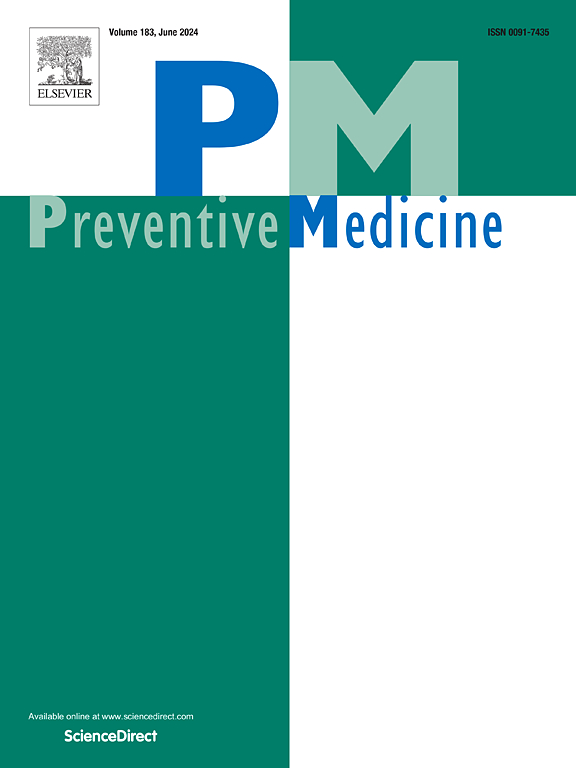Firearm possession among emergency department youth and young adults: A latent class analysis
IF 4.3
2区 医学
Q1 MEDICINE, GENERAL & INTERNAL
引用次数: 0
Abstract
Introduction
Firearm injuries are a leading cause of death for youth/young-adults. We utilized latent class analysis to identify distinct motivational/behavioral patterns of firearm possession in a youth/young-adult emergency department sample to inform prevention strategies.
Methods
Cross-sectional data were obtained from surveys conducted among youth/young-adults (age = 16–29; n = 1311) seeking emergency department treatment (7/10/2017–6/25/2018). Latent class analysis was performed for individuals reporting firearm possession (n = 223) using five variables: carriage frequency, social carriage, risky firearm behaviors, ownership/carriage for protection, and recreational ownership/carriage. Descriptive statistics were examined.
Results
In this sample, 17.0 % reported having firearms (age-22.7; 48.0 %-male; 49.3 %-Black; 52.5 %-public assistance). Latent class analysis identified four classes: 1-recreational possession (n = 51); 2-possession for protection with low carriage (n = 60); 3-carriage for protection with low risky firearm behaviors (n = 76); and 4-carriage for protection with high risky firearm behaviors (n = 36). Class-1 (recreational possession) had low firearm victimization, violence exposure, and community violence. This class primarily kept long-guns with secure storage patterns. Class-2 (protection with low carriage) were mostly female youth/young-adults with children and reported moderately high rates of violence exposure. Nearly 20 % stored their firearm unlocked. Class-3 and -4 endorsed firearm carriage for protection, with Class-4 also engaging in risky firearm behaviors. Both classes had high violence exposure; however, Class-4 had higher risk profiles including higher marijuana misuse, mental health symptoms, and firearm victimization.
Conclusions
Among an emergency department sample, four distinct firearm possession classes emerged with different risk levels. Understanding firearm behaviors and risk/protective factors is critical to tailoring healthcare-focused interventions to address individual needs and reduce injury risk.
急诊科青少年中持有枪支的情况:潜类分析。
导言:枪支伤害是青少年死亡的主要原因之一。我们利用潜类分析来确定青少年急诊科样本中持有枪支的不同动机/行为模式,从而为预防策略提供依据:横截面数据来自对寻求急诊治疗的青少年(年龄 = 16-29;n = 1311)进行的调查(7/10/2017-6/25/2018)。使用五个变量对报告拥有枪支的个人(n = 223)进行了潜类分析:携带频率、社交携带、危险枪支行为、为保护而拥有/携带以及娱乐性拥有/携带。对描述性统计进行了研究:在该样本中,17.0% 的人报告拥有枪支(年龄-22.7 岁;48.0%-男性;49.3%-黑人;52.5%-公共援助)。潜类分析确定了四个类别:1-娱乐性持有(n = 51);2-为保护而持有,携带量低(n = 60);3-为保护而携带,枪支行为风险低(n = 76);4-为保护而携带,枪支行为风险高(n = 36)。1类(娱乐性持有)的枪支受害率、暴力接触率和社区暴力率都较低。这一类人主要持有长枪,储存方式安全。第 2 类(保护性低携带)主要是有孩子的女性青年/年轻成年人,报告的暴力暴露率中等偏高。近 20% 的人存放枪支时没有上锁。第 3 类和第 4 类赞同携带枪支以提供保护,第 4 类也有危险的持枪行为。两类人群都有较高的暴力暴露率;然而,第四类人群有更高的风险特征,包括较高的大麻滥用率、精神健康症状和枪支受害率:结论:在急诊科样本中,出现了四个不同的持有枪支类别,其风险程度各不相同。了解持枪行为和风险/保护因素对于定制以医疗保健为重点的干预措施以满足个人需求和降低伤害风险至关重要。
本文章由计算机程序翻译,如有差异,请以英文原文为准。
求助全文
约1分钟内获得全文
求助全文
来源期刊

Preventive medicine
医学-公共卫生、环境卫生与职业卫生
CiteScore
7.70
自引率
3.90%
发文量
0
审稿时长
42 days
期刊介绍:
Founded in 1972 by Ernst Wynder, Preventive Medicine is an international scholarly journal that provides prompt publication of original articles on the science and practice of disease prevention, health promotion, and public health policymaking. Preventive Medicine aims to reward innovation. It will favor insightful observational studies, thoughtful explorations of health data, unsuspected new angles for existing hypotheses, robust randomized controlled trials, and impartial systematic reviews. Preventive Medicine''s ultimate goal is to publish research that will have an impact on the work of practitioners of disease prevention and health promotion, as well as of related disciplines.
 求助内容:
求助内容: 应助结果提醒方式:
应助结果提醒方式:


